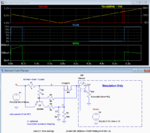- Joined
- Jul 4, 2009
- Messages
- 16,238
- Helped
- 5,140
- Reputation
- 10,309
- Reaction score
- 5,122
- Trophy points
- 1,393
- Location
- Aberdyfi, West Wales, UK
- Activity points
- 137,427
More like open drain in that configuration but driving the output latch high makes the TRIS (tri-state) bit behave like an open source pull-up.So basically it rather acts as an open source output.
More generally with PICs, if the output s driven low and the TRIS register (has one bit per port bit) is used instead of the PORT register it can be used in open-drain fashion to interface to devices that can only tolerate low voltages. A PIC on 5V can drive a 3.3V device for example if the pins are externally pulled up to the 3.3V supply.
Brian.

